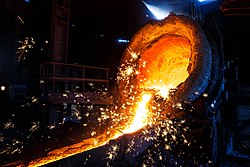| Steels |
|---|
 |
| Phases |
| Microstructures |
| Classes |
| Other iron-based materials |
High-strength low-alloy steel (HSLA) is a type of alloy steel that provides better mechanical properties or greater resistance to corrosion than carbon steel. HSLA steels vary from other steels in that they are not made to meet a specific chemical composition but rather specific mechanical properties. They have a carbon content between 0.05 and 0.25% to retain formability and weldability. Other alloying elements include up to 2.0% manganese and small quantities of copper, nickel, niobium, nitrogen, vanadium, chromium, molybdenum, titanium, calcium, rare-earth elements, or zirconium.[1][2] Copper, titanium, vanadium, and niobium are added for strengthening purposes.[2] These elements are intended to alter the microstructure of carbon steels, which is usually a ferrite-pearlite aggregate, to produce a very fine dispersion of alloy carbides in an almost pure ferrite matrix. This eliminates the toughness-reducing effect of a pearlitic volume fraction yet maintains and increases the material's strength by refining the grain size, which in the case of ferrite increases yield strength by 50% for every halving of the mean grain diameter. Precipitation strengthening plays a minor role, too. Their yield strengths can be anywhere between 250–590 megapascals (36,000–86,000 psi). Because of their higher strength and toughness HSLA steels usually require 25 to 30% more power to form, as compared to carbon steels.[2]
Copper, silicon, nickel, chromium, and phosphorus are added to increase corrosion resistance. Zirconium, calcium, and rare-earth elements are added for sulfide-inclusion shape control which increases formability. These are needed because most HSLA steels have directionally sensitive properties. Formability and impact strength can vary significantly when tested longitudinally and transversely to the grain. Bends that are parallel to the longitudinal grain are more likely to crack around the outer edge because it experiences tensile loads. This directional characteristic is substantially reduced in HSLA steels that have been treated for sulfide shape control.[2]
They are used in cars, trucks, cranes, bridges, roller coasters and other structures that are designed to handle large amounts of stress or need a good strength-to-weight ratio.[2] HSLA steel cross-sections and structures are usually 20 to 30% lighter than a carbon steel with the same strength.[3][4]
HSLA steels are also more resistant to rust than most carbon steels because of their lack of pearlite – the fine layers of ferrite (almost pure iron) and cementite in pearlite.[5] HSLA steels usually have densities of around 7800 kg/m3.[6]
Military armour plate is mostly made from alloy steels, although some civilian armour against small arms is now made from HSLA steels with extreme low temperature quenching.[7]
- ^ "Classification of Carbon and Low-Alloy Steels". Retrieved 2008-10-06.
- ^ a b c d e "HSLA Steel". 2002-11-15. Archived from the original on 2009-12-30. Retrieved 2008-10-11.
- ^ Degarmo, p. 116.
- ^ Same density as carbon steel, see next paragraph
- ^ Kant, Krishan; Kumar, Lalit; Verma, Kanika; Rawat, Deepak (10 April 2016). "Effects of Various Process Parameters by Tensile and Toughness Test on Weld Joint Quality of HSLA Steel during Submerged Arc Welding". International Journal of Scientific Research in Science, Engineering and Technology. 2 (2): 652–659. doi:10.32628/IJSRSET1622216 (inactive 1 November 2024).
{{cite journal}}: CS1 maint: DOI inactive as of November 2024 (link) - ^ "Stainless steel properties for structural automotive applications" (PDF). Euro Inox. June 2000. Archived from the original (PDF) on 2007-09-28. Retrieved 2007-08-14.
- ^ Cite error: The named reference
Sweborwas invoked but never defined (see the help page).